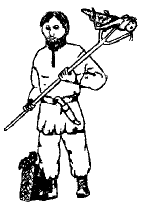St. Urho's Day | March 16, 2013
HAPPY ST. URHO'S DAY
all this is taken from sainturho.com
The Origin of St. Urho
 The
legend of St. Urho is not the product of one person, but of many. The
original character is usually traced to Virginia, Minnesota, but like
most good legends, there have been many voices in creating the history
of St. Urho.
The
legend of St. Urho is not the product of one person, but of many. The
original character is usually traced to Virginia, Minnesota, but like
most good legends, there have been many voices in creating the history
of St. Urho.
St. Urho was created by Richard Mattson, who worked at Ketola's Department Store in Virginia, Minnesota. Mattson is generally credited with conjuring up a Finnish counterpart to St. Patrick in the spring of 1956. Just as Patrick had driven the snakes from Ireland, Mattson's saint drove a plague of frogs from Finland. There were several Finnish names suggested, but Saint Ero or Saint Jussi, or even Toivo or Eino, just didn't have the correct ring of a saintly name. Urho Kekkonen became president of Finland in 1956, and some believe that is where the name came from. Others say that Kekkonen was called "Saint Urho" by the citizens of Finland, and the name was attached to Mattson's legend.
Gene McCavic took the St. Urho legend and, with help from Mattson, wrote an "Ode to St. Urho". It told of a boy ("poika", Finnish for "boy") named Urho who got strong on sour whole milk ("feelia sour") and fish soup ("kala mojakka"). In the original, Urho chases out "tose 'Rogs" (those frogs) with his loud voice. The original Ode also celebrates St. Urho's Tay as "twenty-fourth of May". The original poem was written on a piece of wrapping paper, and is on display at Ironworld Discovery Center in Chisolm, Minnesota.
[Brief note on the Finnish language: Finnish has several fewer consonants than English. Missing are B, C, D, and G. Consequently there are no sounds for those letters, and B becomes P, C becomes S or K, D becomes T, and G becomes K. When Finnish rally drivers talk about transmission problems with their cars, they refer to it as a "kearpox". There are also no articles in Finnish sentence structure -- the, a or an are not part of Finnish grammar.]
Also credited as the originator of the St. Urho legend is Dr. Sulo Havum�ki, a psychology professor at Bemidji State College in Bemidji, Minnesota. He is credited with changing the plague to grasshoppers, who were consuming the grape crop that would become wine in ancient Finland. (Pre-historic Finland was allegedly a much warmer place than it is today.) St. Urho's triumph was saving the vineyards and the jobs for those who picked the grapes. That is how St. Urho became the Patron Saint of Finnish Vineyard Workers.
The legend spread, originally across Minnesota to Finnish settlements on the Mesabi Iron Range, and to Menahga, New York Mills, Wolf Lake, and of course, Finland. St. Urho's Day is now celebrated in towns with Finnish heritage across Michigan's Upper Peninsula; Thunder Bay, Ontario; Burlington, Vermont; Butte, Montana; and Hood River, Oregon.
Today, the St. Urho tradition is carried on in many Finnish communities, sometimes as an excuse to add an extra day of rowdy celebration to the St. Patrick's Day festivities. In many Finnish-American communities, however, St. Urho's Day is the celebration, and St. Pat's feast day is merely an afterthought, a day to sleep off the hangover.
Timo Winkenen
Comments
Post a Comment